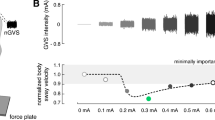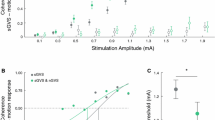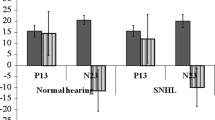Abstract
Background
Balance control is based on multisensory interaction. In addition to vestibular, proprioceptive and visual information, it seems that auditory input also plays an important role.
Objectives
The aim of the study was to investigate the effect of hearing on vestibulospinal coordination and to obtain deeper knowledge about mechanisms of audiovestibular interaction.
Materials and methods
In normal hearing, healthy subjects who performed the Unterberger (Fukuda) stepping test with and without frontal presentation of noise, the distance of displacement, the angle of displacement and the angle of rotation were measured by means of ultrasound based cranio-corpo-graphy (CCG). Additionally, subjective estimation of the effect of auditory input was compared to objective test results.
Results
In the noise condition, there was a significant improvement in the distance of displacement (mean with noise 66.9 cm± 33.5 standard deviation, SD, mean without noise 77.0 cm±32.7 SD, p< 0.001) and in the angle of rotation (mean with noise 14.2°± 10.1 SD, mean without noise 28.3°± 20.2 SD, p< 0.001), while no difference was found within the conditions regarding the angle of displacement (mean with noise 29.1°± 33.5 SD, mean without noise 30.0°± 34.0 SD, p= 0.641). Side-specific analysis revealed a positive correlation between angle of displacement and angle of rotation in the condition without noise (Spearman r = 0.441, p< 0.001). The rate of agreement between subjective estimation of noise influence and objective test results ranged between only 43% and 63%, depending on the question and endpoint.
Conclusion
Hearing had a clearly beneficial effect of auditory inputs on vestibulospinal coordination, especially for distance of displacement and angle of rotation.





Similar content being viewed by others
References
Akeroyd MA (2014) An overview of the major phenomena of the localization of sound sources by normal-hearing, hearing-impaired, and aided listeners. Trends Hear. https://doi.org/10.1177/2331216514560442
Bracha HS, Seitz DJ, Otemaa J et al (1987) Rotational movement (circling) in normal humans: sex difference and relationship to hand, foot and eye preference. Brain Res 411:231–235
Deutsches Insitut Für Normung e. V., ISO 7029:2000, Acoustics—Statistical distribution of hearing thresholds as a function of age. DIN EN ISO 7029:2001-01
Easton RD, Greene AJ, Dizio P et al (1998) Auditory cues for orientation and postural control in sighted and congenitally blind people. Exp Brain Res 118:541–550
Fastl H (1987) Ein Störgeräusch für Sprachaudiometrie. Audiol Acoust 2:22–13
Fukuda T (1959) The stepping test: two phases of the labyrinthine reflex. Acta Otolaryngol 50:95–108
Gandemer L, Parseihian G, Kronland-Martinet R et al (2014) The influence of horizontally rotating sound on standing balance. Exp Brain Res 232:3813–3820
Gandemer L, Parseihian G, Kronland-Martinet R et al (2017) Spatial cues provided by sound improve postural stabilization: evidence of a spatial auditory map? Front Neurosci 11:357
Grommes C, Conway D (2011) The stepping test: a step back in history. J Hist Neurosci 20:29–33
Honaker JA, Boismier TE, Shepard NP et al (2009) Fukuda stepping test: sensitivity and specificity. J Am Acad Audiol 20:311–314 (quiz 335)
Kanegaonkar RG, Amin K, Clarke M (2012) The contribution of hearing to normal balance. J Laryngol Otol 126:984–988
Maheu M, Sharp A, Landry SP et al (2017) Sensory reweighting after loss of auditory cues in healthy adults. Gait Posture 53:151–154
Makous JC, Middlebrooks JC (1990) Two-dimensional sound localization by human listeners. J Acoust Soc Am 87:2188–2200
Minor LB, Solomon D, Zinreich JS et al (1998) Sound- and/or pressure-induced vertigo due to bone dehiscence of the superior semicircular canal. Arch Otolaryngol Head Neck Surg 124:249–258
Munnings A, Chisnall B, Oji S et al (2015) Environmental factors that affect the Fukuda stepping test in normal participants. J Laryngol Otol 129:450–453
Palm HG, Strobel J, Achatz G et al (2009) The role and interaction of visual and auditory afferents in postural stability. Gait Posture 30:328–333
Paquet N, Taillon-Hobson A, Lajoie Y (2014) Fukuda and Babinski-Weil tests: within-subject variability and test-retest reliability in nondisabled adults. J Rehabil Res Dev 51:1013–1022
Rahne T, Seiwerth I, Gotze G et al (2015) Functional results after Bonebridge implantation in adults and children with conductive and mixed hearing loss. Eur Arch Otorhinolaryngol 272:3263–3269
Ross JM, Balasubramaniam R (2015) Auditory white noise reduces postural fluctuations even in the absence of vision. Exp Brain Res 233:2357–2363
Ross JM, Will OJ, Mcgann Z et al (2016) Auditory white noise reduces age-related fluctuations in balance. Neurosci Lett 630:216–221
Rumalla K, Karim AM, Hullar TE (2015) The effect of hearing aids on postural stability. Laryngoscope 125:720–723
Shayman CS, Earhart GM, Hullar TE (2017) Improvements in Gait With Hearing Aids and Cochlear Implants. Otol Neurotol 38:484–486
Stevens MN, Barbour DL, Gronski MP et al (2016) Auditory contributions to maintaining balance. J Vestib Res 26:433–438
Unterberger S (1938) Neue objective registrierbare Vestibularis – Drehreaktion, erhalten durch Treten auf der Stelle. Der Tretversuch. Arch Ohren Nasen Kehlkopfheilkd 145:273–282
Vitkovic J, Le C, Lee SL et al (2016) The contribution of hearing and hearing loss to balance control. Audiol Neurootol 21:195–202
Walther LE, Hormann K, Pfaar O (2010) Recording cervical and ocular vestibular evoked myogenic potentials: part 1: anatomy, physiology, methods and normal findings. HNO 58:1031–1045
Weaver TS, Shayman CS, Hullar TE (2017) The effect of hearing aids and cochlear implants on balance during gait. Otol Neurotol 38:1327–1332
Zhong X, Yost WA (2013) Relationship between postural stability and spatial hearing. J Am Acad Audiol 24:782–788
Author information
Authors and Affiliations
Corresponding author
Ethics declarations
Conflict of interest
I. Seiwerth, J. Jonen, T. Rahne, R. Schwesig, A. Lauenroth, T.E. Hullar, and S.K. Plontke declare that they have no competing interests.
All procedures performed in studies involving human participants were in accordance with the ethical standards of the institutional and/or national research committee (Nr. 2016-45), and with the 1975 Helsinki declaration and its later amendments or comparable ethical standards. Informed consent was obtained from all individual participants included in the study.
The supplement containing this article is not sponsored by industry.
Rights and permissions
About this article
Cite this article
Seiwerth, I., Jonen, J., Rahne, T. et al. Influence of hearing on vestibulospinal control in healthy subjects. HNO 66 (Suppl 2), 49–55 (2018). https://doi.org/10.1007/s00106-018-0520-7
Published:
Issue Date:
DOI: https://doi.org/10.1007/s00106-018-0520-7




